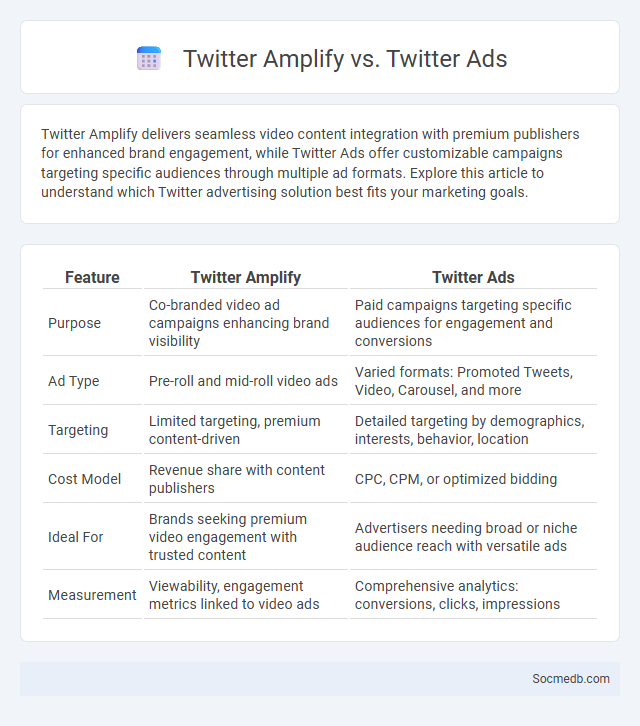
Photo illustration: Twitter Amplify vs Twitter Ads
Twitter Amplify delivers seamless video content integration with premium publishers for enhanced brand engagement, while Twitter Ads offer customizable campaigns targeting specific audiences through multiple ad formats. Explore this article to understand which Twitter advertising solution best fits your marketing goals.
Table of Comparison
| Feature | Twitter Amplify | Twitter Ads |
|---|---|---|
| Purpose | Co-branded video ad campaigns enhancing brand visibility | Paid campaigns targeting specific audiences for engagement and conversions |
| Ad Type | Pre-roll and mid-roll video ads | Varied formats: Promoted Tweets, Video, Carousel, and more |
| Targeting | Limited targeting, premium content-driven | Detailed targeting by demographics, interests, behavior, location |
| Cost Model | Revenue share with content publishers | CPC, CPM, or optimized bidding |
| Ideal For | Brands seeking premium video engagement with trusted content | Advertisers needing broad or niche audience reach with versatile ads |
| Measurement | Viewability, engagement metrics linked to video ads | Comprehensive analytics: conversions, clicks, impressions |
Introduction: Understanding the Twitter Marketing Landscape
Twitter's dynamic platform offers real-time engagement, making it essential for businesses seeking rapid audience connection and influencer collaboration. With over 330 million active users worldwide, Twitter provides vast opportunities for targeted advertising and brand visibility. To maximize your impact, understanding Twitter's trends, hashtags, and algorithm behavior is crucial for effective marketing strategies.
What is Twitter Amplify?
Twitter Amplify is a program that enables brands and advertisers to promote real-time video content alongside premium live broadcasts and popular video clips. Your marketing campaigns benefit from increased engagement by pairing ads with trending sports events, news, and entertainment videos shared on Twitter. This targeted approach ensures your message reaches a highly engaged audience in real-time, maximizing visibility and impact.
Overview of Twitter Ads
Twitter Ads offers a versatile advertising platform enabling brands to reach targeted audiences through promoted tweets, accounts, and trends. Key features include precise audience targeting based on demographics, interests, and user behavior, alongside real-time analytics for campaign performance tracking. With options like cost-per-click (CPC), cost-per-impression (CPM), and cost-per-engagement (CPE), Twitter Ads supports diverse marketing objectives such as brand awareness, lead generation, and direct conversions.
Defining Amplification on Twitter
Amplification on Twitter refers to the process of increasing the reach and engagement of your content through retweets, likes, and replies. Effective amplification leverages the platform's real-time interaction and hashtag systems to expand your message beyond your immediate followers. Understanding this dynamic enables you to maximize visibility and influence within targeted communities.
Key Differences Between Twitter Amplify and Twitter Ads
Twitter Amplify enables content sponsors to align their video ads with premium live or on-demand content, enhancing brand engagement through contextually relevant video placements. Twitter Ads offer broader campaign customization options across various ad formats like promoted tweets, accounts, and trends, targeting specific audiences with detailed demographic and interest-based filters. Amplify prioritizes video sponsorship within premium content categories, while Twitter Ads emphasize versatile advertising strategies for diverse marketing objectives.
Use Cases: When to Use Amplify vs Twitter Ads
Amplify is ideal for brands looking to boost organic content with premium video placements, harnessing Twitter's native audience engagement to amplify existing campaigns effectively. Twitter Ads offer more granular targeting options for direct-response campaigns, allowing you to tailor promotions based on demographics, interests, and behaviors to drive conversions. Your choice depends on whether you aim to maximize content reach or achieve precise campaign objectives with measurable ROI.
The Power of Organic Amplification
Organic amplification on social media exponentially increases brand visibility by leveraging authentic user engagement without paid promotion. Content that resonates naturally prompts shares, comments, and likes, creating a ripple effect across networks and boosting reach to wider, targeted audiences. Brands that master organic amplification benefit from higher trust, stronger community relationships, and sustainable growth through genuine interactions.
Cost Comparison: Amplify vs Twitter Ads
Amplify offers more cost-effective social media advertising with lower average CPC (Cost Per Click) rates compared to Twitter Ads, often resulting in higher ROI for brand campaigns. Twitter Ads demand higher budgets due to competitive bidding and premium audience targeting capabilities but provide advanced engagement analytics and real-time trend integration. Brands seeking budget-friendly solutions benefit from Amplify's streamlined pricing, while those targeting niche audiences prioritize Twitter Ads' precise ad placement and interactive formats.
Measuring Success: Metrics for Each Strategy
Measuring success on social media requires analyzing key performance indicators (KPIs) tailored to each strategy, such as engagement rate, reach, and conversion rate for content marketing. For paid advertising, metrics like click-through rate (CTR), cost per acquisition (CPA), and return on ad spend (ROAS) provide insight into campaign effectiveness. Influencer marketing success can be gauged through follower growth, brand mentions, and sentiment analysis.
Choosing the Right Approach for Your Brand
Selecting the right social media approach for your brand hinges on understanding your target audience's behavior and preferences on platforms like Instagram, Facebook, and LinkedIn. Tailoring content strategies to fit each channel's unique format--such as visual storytelling on Instagram or professional insights on LinkedIn--maximizes engagement and brand visibility. Leveraging data analytics tools like Sprout Social or Hootsuite provides actionable insights to refine campaigns and boost ROI effectively.
 socmedb.com
socmedb.com